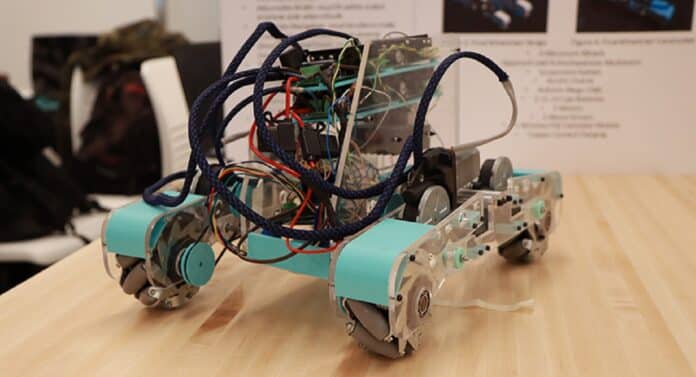A team of Purdue University graduates has developed a patent-pending, dynamically adjustable wheelchair prototype designed to help users more efficiently and safely navigate airports and board aircraft. It moves through narrow aisleways to their seats. The wheelchair travels omnidirectionally and features an improved turn radius compared to currently available wheelchairs.
The original design won the 2020 FAA Challenge: Smart Connected Aviation Student Competition. The Purdue teams validated the design concept by testing it on various flooring surfaces and through spaces replicating aircraft aisleways’ dimensions.
After studying previous versions of the design, scientists updated the software, redid the electrical setup, and redesigned the mechanical features of the wheelchair. This results in a safer device than traditional methods that transport passengers to planes.
The wheelchair is cost-efficient for airports and reduces the number of ushers assisting those with limited mobility. The Purdue Research Foundation Office of Technology Commercialization has applied for a patent on intellectual property.
Peter Ponticello, a recent alumnus of Purdue University’s Polytechnic Institute and a team member who worked on fine-tuning the design, said, “It is extremely difficult for a passenger to board an airplane without requiring constant assistance from a dedicated usher throughout the process,” He also said, navigating an airport requires addressing various floor surfaces and narrow aircraft aisles.”
The current standard for wheelchair users is to transfer between multiple devices: wheelchairs, airport buggies, and aisle chairs when boarding and deplaning a commercial aircraft.
Brad Duerstock, a power wheelchair user and professor of practice in the Weldon School of Biomedical Engineering and School of Industrial Engineering, said, “The requirement to transfer to a normal airline seat is fraught with many hazards that have led to personal injury to the wheelchair user or the airline attendant.”
“It always delays the boarding of passengers who must wait for the wheelchair user to be physically transferred into the aisle chair, enter into the airplane, and then transfer again into an airplane seat. This is not only dangerous but very inefficient.”
Ponticello, Connor Edwards, Logan Gardocki, and Cole Mulzer are recent Purdue graduates, and Jack Moran is scheduled to graduate this year. They worked on a remote-operated, battery-powered base for the wheelchair, functioning as all three traditionally employed devices.
Researcher said, “This wheelchair allows for those who need to utilize a wheelchair in an airport to do so without the constant assistance of an usher. This greatly reduces the amount that airports spend on ushers who assist those with limited mobility.”
The original team that worked on the concept disclosed it to the Purdue Research Foundation Office of Technology Commercialization, which has applied for a patent on intellectual property.
Business partners plan to extend the concept further, including the ability to convey a passenger from an airport entry to a specific gate and aisle seat on an airplane.
